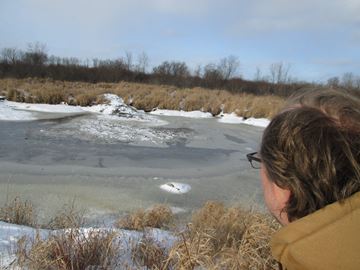Merry Christmas! The present I got you is one-of-a-kind and really hard to find. It’s a nice article from a property-owner who enjoys the beavers in his pond and is having fun watching them. No need to thank me. The look on your face is thanks enough.
A crash course in beaver denizenery
When three beavers in our Back 50 pond whacked their tales – in unison, no less – I was smitten.

From my lawn chair on shore, they’re always entertaining. Industrious. Patient. Determined. Funny.
Hey, the internet is spotty in our parts and this is 4D TV – without the cumbersome pick-and-pay contract.
My recent fascination with them coincided with what would become our worst drought in decades. Our pond’s about the length of a football field – the larger Canadian field, fittingly, given its inhabitants, eh.
As the water level dropped drastically, it resembled a large puddle dotted with what appeared to be about a dozen beaver lodges. But were there really more lodges than in previous years? Or had the receding water simply made them more visible?
Ahh, Denis! I can’t tell you how refreshing it is to read about someone actually watching beavers instead of just trapping them because they’re a nuisance. He’s located in Peterborough, across Lake Ontario from New York. Maybe he has benefited from our friends in the area? I myself started watching beavers a million years ago because they were ‘cool’ to watch and I was curious about them. It opened the door for learning and helped me be forever hooked.
Seems Denis is watching them during a drought year, while the pond shrinks. This makes several other lodges visible that he hadn’t noticed before. He wonders whether more beavers move into a pond in drought and whether there will be competition.What he doesn’t realize, is that beavers don’t ‘go’ where there’s water, they more or less make water wherever they ‘go’. Beaver ponds in drought contained 9 times more water than equivalent ponds without beaver according to Dr. Glynnis Hood’s Alberta research. For the most part, the strange thing is he asks people who tell him the right answer. Go figure.
“You probably already know that beavers are territorial,” Lisa Soloman, a management biologist with the Ministry of Natural Resources (MNR), told me.
Uh, no. I didn’t. But go on, I pleaded.
“All beavers in a pond are related,” she continued, explaining that a pair will breed, keep their three to five “kits” nearby for about two years, then send them off to university or to teach English overseas.
So my pond is not overcrowded. And those additional lodges I thought I saw are, according a friend and hunter, merely failed construction attempts.
Is there anything, then, I can do to ensure a second season of my backyard reality TV?
“I would say nothing!” says Soloman. “This is how nature works. If the conditions aren’t good for them, they may not survive or they may disperse…But if it’s good habitat, new beavers can move in and claim the unoccupied territory.”
Wow, not only is Denis enjoying them now, he wants them to stay next year. I appreciate Lisa Solomon’s mostly accurate advice. But I disagree with one part. ‘Nature’ is no longer the thing that decides whether beavers will stick around or not. Human interest is. And if you’re happy to have those little flat-tails as your neighbors I would say the odds of them sticking around are very, very good.
You might also plant a little willow from cuttings around the pond’s edge. Good for the pond anyway and the beavers will help keep it thriving. Happy watching!
Speaking of beaver lodges, I thought this was a great photo of the one Suzi Eszterhas took in Napatopia. How’s that for ‘Nature in the City’? Happy Christmas!






 something unusual happening came in autumn after a month of no rain when I measured the water level. I do this at least once a week downstream from our cabin and was surprised to find that instead of dropping an inch or so, it had actually risen 2 inches. I attributed it to mismeasurement until I took my walk.
something unusual happening came in autumn after a month of no rain when I measured the water level. I do this at least once a week downstream from our cabin and was surprised to find that instead of dropping an inch or so, it had actually risen 2 inches. I attributed it to mismeasurement until I took my walk.








































